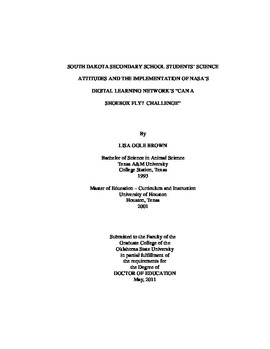| dc.contributor.advisor | Marks, Steve | |
| dc.contributor.author | Brown, Lisa Ogle | |
| dc.date.accessioned | 2013-11-26T08:34:14Z | |
| dc.date.available | 2013-11-26T08:34:14Z | |
| dc.date.issued | 2011-05 | |
| dc.identifier.uri | https://hdl.handle.net/11244/7323 | |
| dc.description.abstract | Scope and Method of Study: The National Aeronautics and Space Administration (NASA) had taken steps to inspire the next generation of explorers through its education programs to enhance student and teacher knowledge of science, technology, engineering, and mathematics (STEM). One of these education programs is the Digital Learning Network (DLN), which uses two-way audio and videoconferencing to share the knowledge and expertise of scientists, engineers, and researchers with students and teachers. The purpose of this study is to assess the degree to which the Digital Learning Network will promote attitudes in the secondary science classroom in a rural town in South Dakota. The DLN's "Can A Shoebox Fly? Challenge" was used to determine if participating in the "Can A Shoebox Fly? Challenge" will create a positive change in attitudes in students in science and, if there was a change, did it differ among genders. Furthermore, this study tried to determine how effective the DLN is with regards to student interest in STEM careers. | |
| dc.description.abstract | Finding and Conclusions: This study utilized a mixed-methods approach to data collection from secondary science students. A parallel pre- and post science attitudes survey, developed by Ingrid Novodvorsky, was used in addition to face-to-face interviews and evidence collected from the students' notebooks. The findings in this study indicate the students' attitude towards science was more positive after the "Can A Shoebox Fly? Challenge" with regards to interest in science class and activities in science class (Factor1); confidence in their ability to do science (Factor 2) as well as their overall interest in science in general. Additionally, both genders showed a positive change in attitudes for the above factors and there was no significant difference between males and females. A negative change in attitudes occurred pertaining to student interest in science related activities outside of school (Factor 3). The same negative change occurred among males and females with no significant difference between the two genders. The implication of this study provides future research with all of NASA's Digital Learning Network modules to enhance students' interest in STEM careers and STEM student achievement. | |
| dc.format | application/pdf | |
| dc.language | en_US | |
| dc.rights | Copyright is held by the author who has granted the Oklahoma State University Library the non-exclusive right to share this material in its institutional repository. Contact Digital Library Services at lib-dls@okstate.edu or 405-744-9161 for the permission policy on the use, reproduction or distribution of this material. | |
| dc.title | South Dakota secondary school students' science attitudes and the implementation of NASA's Digital Learning Network's "Can a Shoebox Fly? Challenge" | |
| dc.contributor.committeeMember | Beller, Caroline | |
| dc.contributor.committeeMember | Bliss, Timm | |
| dc.contributor.committeeMember | Kutz, Mary | |
| osu.filename | Brown_okstate_0664D_11389.pdf | |
| osu.accesstype | Open Access | |
| dc.type.genre | Dissertation | |
| dc.type.material | Text | |
| thesis.degree.discipline | Applied Educational Studies | |
| thesis.degree.grantor | Oklahoma State University | |
